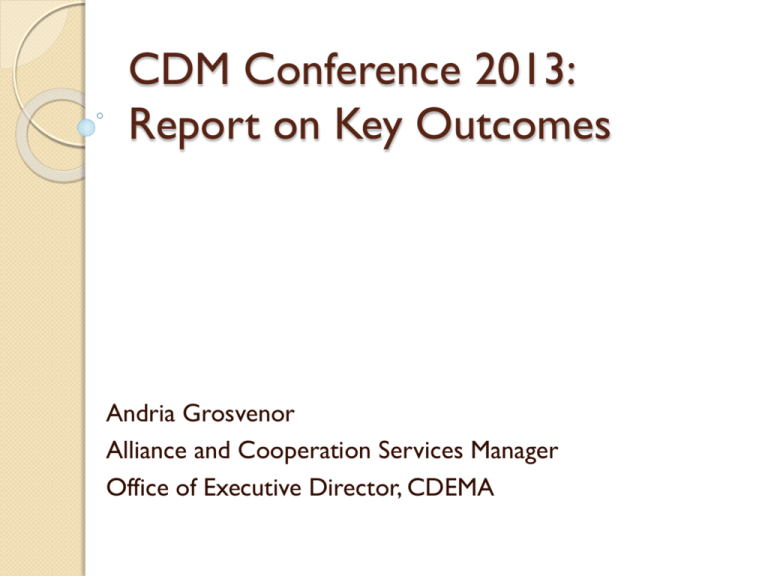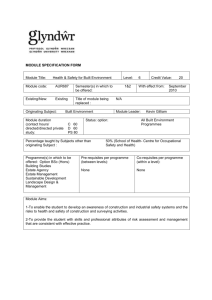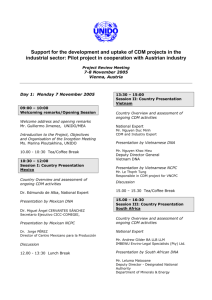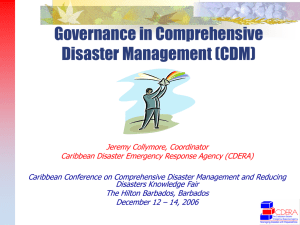Andria Grosvenor
advertisement

CDM Conference 2013: Report on Key Outcomes Andria Grosvenor Alliance and Cooperation Services Manager Office of Executive Director, CDEMA What Were the Objectives? To launch the Caribbean Strategy on Comprehensive Disaster Management 2014-2024. To review and enhance the CDM Strategy Implementation Plan To share experiences on resilient development through sound investment by the public and private sectors To examine the benefits of investment in CDM To facilitate dialogue on opportunities for investing in CDM … And Expected Results Improved stakeholder awareness of the CDM Strategy 2014-2024; Action Plan for Implementing CDM Strategy; Recommended actions for strengthened investment in CDM; Exchanges on CDM related research, tools, products, information and education materials; Compendium of papers on experiences in investment for disaster resilience – social and economic; Greater awareness of the benefits and potential opportunities for investment in CDM; … Delivered Through Partner Consultation Sessions Commissioned research papers built around the conference theme Opening Ceremony Plenary Sessions & Panel Discussions Conference Exhibition Lunch Time “Talk de Talk” Youth Session Conference Tour Film Festival CDM Stakeholder Parliament Result 1: Improved Stakeholder Awareness CDM Strategy Stakeholder Awareness of CDM Strategy CDM Parliament was convened December 2-6, 2013 and CDM Strategy shared on December 3rd Representation over the period was 258 delegates ◦ 36 Countries – Caribbean, Latin America, Europe, North America, Pacific ◦ Disaster management practitioners, educators, researchers, development partners, community and nongovernmental actors ◦ 51 youth Several persons joined the Conference online through the live streaming of sessions. Continued sharing to enhance awareness. Safer, more resilient and sustainable CDEMA Participating States through Comprehensive Disaster Management Outcome 1: Strengthened institutional arrangements for Comprehensive Disaster Management implementation at national and regional levels Outcome 2: Increased and Outcome 3: Improved sustained knowledge management and learning for effectiveness of CDM at Comprehensive Disaster sectoral levels Management Outcome 4: Strengthened and sustained capacity for a culture of safety and community resilience in Participating States 1.1. CDEMA CU and NDO strengthened/restructured for effective support of the implementation, monitoring and evaluation of CDM in Participating States 2.1. Regional Disaster Risk Management Network for informed decision-making at all levels improved 3.1. Disaster Risk Management program at the sectoral level improved 4.1. Standards for safe communities developed, agreed and applied 1.2. CDM is integrated into national policies, strategies and legislation by Participating States 2.2. Infrastructure for fact-based policy and decision making established/strengthened 3.2. Hazard information integrated into sectoral development planning and programming 4.2. Community-Based Disaster Management capacity built/ strengthened for vulnerable groups 1.3. Partners programming aligned to national/country and regional CDM programming and priorities in the Caribbean Region 2.3. Incorporation of local/ community and sectoral based knowledge into risk assessment improved 3.3. Disaster and climate risk proofing of development programming and investment decision-making at the sectoral level strengthened 4.3. Community Early Warning Systems, integrated, improved and expanded 1.4. Effective and efficient coordination for preparedness, response and recovery at the national and regional levels 2.4. Educational and training materials for CDM standardized, improved and applied in the region 4.4. Community –Based Disaster Management capacity built/ strengthened to address gender and vulnerable group needs. 1.5. Resources for CDM reflect the level of need of CDEMA Participating States and CDEMA CU Gender Mainstreaming Climate Change ICT Environmental Sustainability Result 2: Action Plan for Implementing CDM Strategy Action Plan for Implementing CDM Strategy Validated/Updated Objectives Statements for the 4 CDM Strategy Outcomes Report shared by Session Facilitators Action Plan for Implementing CDM Strategy Identified Key Results for Emerging Sectors (a) Finance and Economic Development and (b) Physical and Environmental Planning: ◦ Scientific data to inform the planning process; ◦ Spatial plans taking into account biological, physical and social elements; ◦ Baseline information for what needs to be addressed to improve resilience in the financial system. How Were the Cross Cutting Themes Treated In the CDM Implementation Plan and Conference Discussions? GENDER There is general consensus that gender considerations is a critical requirement for resilience building and as such, financing of gender mainstreaming in DRR is a good invest. The Implementation Plan of the CDM Strategy 2012-2024 therefore calls attention to the need for gender analysis of and mainstreaming into all relevant actions. CLIMATE CHANGE • An agreement has been reached that the impact of climate change is clear in the region as evidenced by more intense flooding from heavy rainfalls, landslide, stronger hurricane, intensified dry periods etc: • CDM Strategy 2007-2012 and HFA 2005 -2015 assessment/review has identified climate change as an important emerging issue for resilience building. • It has been determined therefore that investment in climate smart infrastructure is vital to resilience building. CLIMATE CHANGE • Specifically investment to making critical and economic infrastructure is ongoing and must be intensified in: Hospitals and small health facilities Road networks Housing stock; especially those of the poor National Disaster Offices or Situation Rooms for national leadership in times of disasters Drainage systems CLIMATE CHANGE The deliberation and analysis of gaps indicate that investment in regional and national capacities for measuring the impact of all disasters and distinguishing the effects of climate change is important. The ability to measure the impact of climate change is the basis on which ◦ case building for increased investment in disaster risk reduction etc. Can be made ◦ for strengthening the region’s representation and negotiations for funding etc. at international fora ◦ engender the conversion of the DM and CC technical communities in the region as the evidence will show there is little to no separation re hazard exposure and the impact on the ground ICT Concurrent Session 5C: ICT Tools for Resilience Recommended that there be greater focus on GIS applications development in the Caribbean region. Investment in telecommunication/mobile phone technology medium is critical for response and early warning notification. In an effort to ensure it reaches all classes of society including: the poor, middle class and wealthy. ICT SESSION 2 PLENARY: “CDM Strategy Implementation Plan 2014-2024 Investment in scientific assessments is required to inform the spatial planning process. DEWETRA Impact forecasting tools can greatly enhance decision making and requires investment, financial and human capital for data fusion and research. Continuous investment in data sharing and maintenance of DEWETRA platform is required to ensure that its usefulness is maximized. Environment Hyogo Framework for Action (HFA) II consultation Evidence of the incorporation of HVA into environmental impact assessments and land use planning is important. Caribbean Health Disaster Risk Reduction Committee (HSSC) Noted that the SMART Hospitals Initiative was designed to establish an integrated approach to building and retrofitting of health care facilities to ensure that they are environmentally friendly and disaster resilient. Result 3&6: Recommended Actions and Opportunities for Investment in CDM Economic Investment for Resilience Appoint a CDM Champion, who will accompany Ministers to CDM Meetings and be in charge of implementing national commitments. The Ministries of Finance and Economic Planning and Social Development to prepare DRM Plan of Actions, which is supported by the national budget. Ministries to be the main drivers for CDM methodologies and tools. Need to transition from DRR planning to mainstreaming into policy, legislation and financing. Public-Private Investment for Resilience Effective public-private partnership can play an important role in post-disaster response and recovery. ◦ Draws on a range of cultures, knowledge and skill sets from both private and public sectors. Strong communication between public and private sector actors is key to facilitating effective public-private partnership. ◦ Access to information and expertise from private and public sectors. Business Recovery planning is vital Social Investment for Resilience We must invest in… Knowledge management Livelihoods Safety net programmes Community based disaster management Social Investment for Resilience We need… A longer term perspective; Integrated and Inter-disciplinary approaches; To seek and address the root causes and not merely the symptoms. Youth Investment for Resilience Youth are a vital part of the civil society mechanism that can be leveraged to support community risk reduction. Identifying a CDM Youth Champion is a viable mechanism for promoting a culture of safety. Result 4: Exchanges on CDMrelated Research Tools, Products, Information and Education Materials CDM EXHIBITION 11 companies participated in the 8th CDM Exhibition showcasing DRR products and tools. Of these: 6 companies showcased products largely aimed at reducing vulnerability to weather and climate hazards and enhancing resilience to disasters. 4 companies showcased products geared at leveraging ICTs for more efficient and effective data gathering, communication, information management and support for emergency operations. 1 company shared information on its activities in the area of sustainable environmental management. The Film Festival and “Talk de Talk” Four films on: ◦ ◦ ◦ ◦ Climate Change Slope Stabilisation Techniques Mitigation Works Model for Disaster Management Operations Talk de Talk: ◦ Community Resilience Tools ◦ Warning Systems ◦ Climate Change/DRR Tools Conference Sessions Decision Making Tools Remote Sensing Tools ICTs for Disaster Risk Management Tools Result 5: Compendium of Papers on Experiences in Investment in Disaster Resilience Publication Five (5) Commissioned Papers - to be Updated ◦ Examining 21st Century Economic Losses From Hazard Events In The Caribbean – The Rationale For Resilient Investment And Recovery ◦ Public-Private Partnerships: A Catalyst for Resilient Investment. ◦ Disaster Risk Reduction and Climate Change Adaptation: Revisiting and Reshaping the Investment Focus ◦ Building The Business Case For Resilient Construction ◦ Social Investment for Disaster Resilience: A Development Imperative Publication Several other papers shared: ◦ Effective Financing and Insurance for Resilience ◦ Constructing and Deconstructing Resilience ◦ ICT Tools for Resilience SO WHAT ABOUT THE WAY FORWARD? Way Forward Presentations Online Conference Evaluation Online Conference Report Strengthening the CDM Implementation Plan Publication of Compendium of Papers Uptake of Conference Recommendations Stakeholder Parliament Meetings





